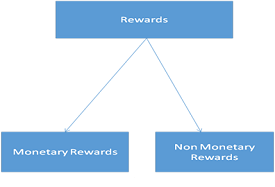Employee rewards and recognition system is not just a positive action towards employees. If it is implemented effectively, it proves to be an efficient tool in encouraging the employees to create and bring business for the company.

Recognizing the efforts of employees and encouraging their morale results in increased productivity and decreased attrition rate. It is a documented fact that an encouraged and dedicated workforce can change the fate of a company.
Establishing and executing a reward system needs careful analysis of the company policies and procedures. Deciding how to recognize employees’ efforts and what to provide them needs thorough analysis of duties and risks involved in a particular job.
Types of Rewards
Reward system of a company should also be in alignment with its goals, objectives, mission and vision. On the basis of the job profile, both monetary and non-monetary rewards can motivate employees to contribute more to the organization.
Monetary Rewards
A hike in salary, incentives, movie tickets, vacation trips, monetary allowances on special occasions, redeemable coupons, cash bonuses, gift certificates, stock awards, free or discounted health check-ups for the complete family and school/tuition fees for employees’ children come under this category.

Non-monetary Rewards
Non-monetary rewards include awards, certificates, letters of appreciation, dinner with boss, redecoration of employee cabin, membership of recreation clubs, perks, use of company facilities, suggestion awards, tie-pins, brooches, diaries, promotion, a say in management, etc.
A mixture of monetary and non-monetary rewards works wonders and drive employees to act competently continuously. A proper and efficient employee reward and recognition program creates harmonious relationships between employees and the employer.
Flexible Pay
The practice of relating pay to performance has been around for a while. However, what’s new is that the percentage of pay that is related to performance and the way in which the same is structured around different elements of performance.
One of the key elements of this flexible pay plan is the strategy of relating pay to performance. This strategy has been followed by many multinational companies worldwide and consists of the overall pay structure being broken down into elements.
The variable pay would be paid out as a percentage of the complete package, subject to the performance of the employee. For instance, if the employee gets a grade of 3 on a scale of 1 to 5 (with 1 as the highest and 5 and the lowest grade), the variable pay would be 60-70% of the eligible amount and if the employee gets a grade of 2, the variable pay would be 110-120% of the eligible amount. The variable component of the salary is determined according to the performance of the employee.
The international practice is to increase the element of the variable pay more than the hierarchy. This would state that at senior levels of the employee hierarchy, the variable component can be as high as 50-60% of the overall pay.




